Spring processing of the garden from pests and diseases: how to spray fruit trees and berry bushes
Spring comes, and simultaneously with the awakening of plants, all kinds of insect pests and pathogens wake up. Therefore, the treatment of the garden in the spring from diseases and pests is one of the most important spring activities for the care of an orchard - fruit trees and berry bushes.
Next, we will consider in detail when, how and what to spray trees and shrubs in spring.
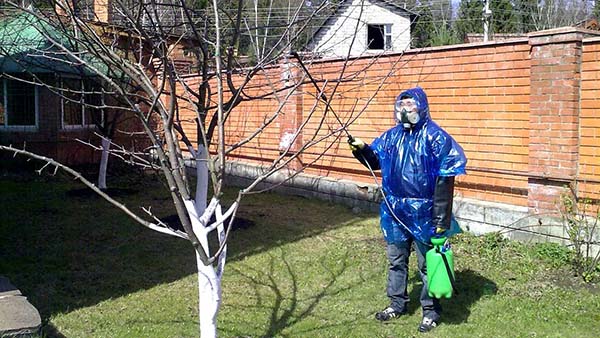
Content
When to treat the garden from diseases and pests in the spring: work schedule (terms)
At different times, different diseases and pests appear, respectively, for each phase of plant development - its own specificity of processing.
So, it is very important not to be late and to spend on time the first early spring garden processing.
However! Don't rush too much. If there is still snow outside the window or the weather is unstable: it often rains, sleet, fog, then the processing at this time will be simply ineffective.
therefore first treatment (early spring eradication spraying) can be done only when it is stable and warm (+4 .. + 5 degrees during the day and preferably not lower than 0 at night, you can -1 ..- 2).
By the way! Insect pests begin to wake up and crawl out of their shelters just at a temperature of about +4 .. + 5 degrees.
Obviously, it is very difficult to name specific dates, where easier to navigate the phases of development of your plants.
So, as a rule, garden treatments in spring are carried out in the following stages of plant development:
- Before bud break, when they are still completely closed (asleep);
This processing is also called "early spring eradication spraying”Or“ on a bare tree ”, when no signs of awakening (vegetation) have yet appeared on the plant.
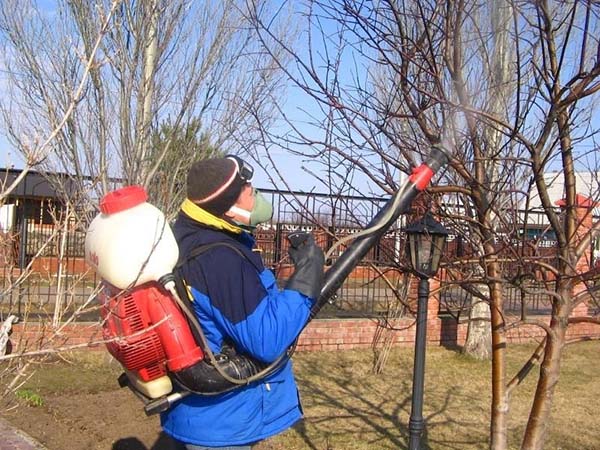
Note! Instead of processing on dormant buds, some gardeners spray on already, so to speak, that have begun to wake up, i.e. during their swelling (at the very beginning).
- "Along the green cone." When the buds have already burst, but the leaves have not yet appeared (unfolded).
- "By rosebuds".
Interesting! Sometimes the treatment is carried out just before flowering, when the buds are about to open, or even during the period of direct flowering (but only against diseases).
- "On the ovary with a pea" (after flowering).
Note! If it seems to you that it is unrealistic to carry out such a number of treatments, then this is not at all the case, even if you are at the dacha only on weekends (1-2 days a week). Each stage lasts more than one day. In addition, you can track all stages on city trees.
Video: types of spring spraying - 4 processing phases
Before bud break or early spring spraying
The first treatment can be carried out even before bud break, when they (buds) are still completely closed (are in a dormant state).
The snow has already melted and melted, the temperature is positive - +4 .. + 5 degrees during the day, at night above or near 0 (zero).
Moreover, the first spraying, as a rule, is carried out both from diseases and from the wintering stages of insect pests.
By the way! The site already has detailed material on how to conduct spring eradication garden spraying.
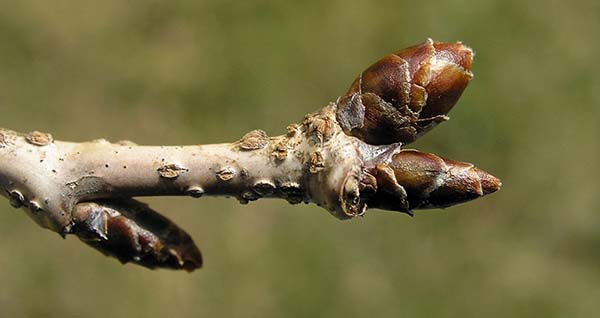
"Along the green cone"
Spraying in the "green cone" phase is considered the most important and most favorable period for treating the garden from diseases and pests.
This phase is characterized by the fact that the buds on the trees have already burst, but the leaves have not yet unfolded, although they are already clearly visible (hence the "green cone").
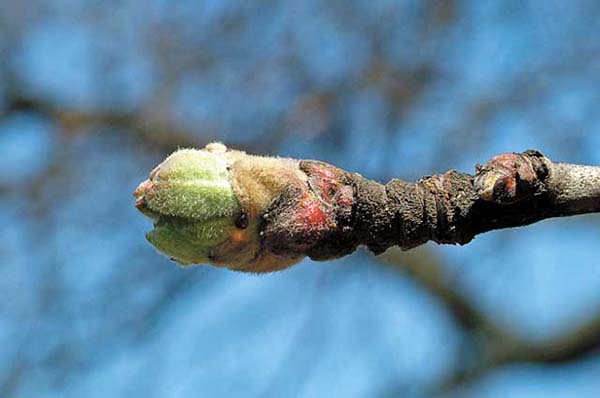
Important! If for some reason you did not carry out processing at the previous stage, then it is better to hurry up, since the duration of this phase ("green cone") is relatively short. Moreover, if there is good sunny weather, a stable temperature is above +10 degrees, then the kidneys will open quite quickly.
At this stage, as a rule, are already using more serious drugs such as Horus (fungicide against diseases), Decis Profi (insecticide), which can be mixed (to prepare a tank mixture from them).
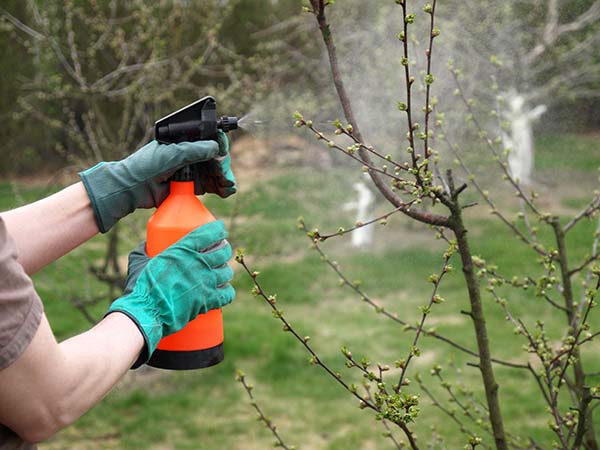
However, if you skipped the previous treatment, you can still spray now. Bordeaux mixture or one of the special solutions based on copper or ferrous sulfate from urea.
Specificity! Horus works great at low positive temperatures (from +4 .. + 5), a Speedon the contrary, works better at higher temperatures (above +15)... therefore before flowering (for example, in the "green cone" phase) you can spray Horus, a Soon - already at the “rose bud” stage and after flowering (“pea-sized ovaries”).
At the same stage, for additional protection of trees from insect pests, you can put on the trunks trapping belts, erect and hang on trees glue traps, pheromone houses.
Interesting! It is at this phase that the apple blossom beetle (weevil) begins its activity.
In the fight against him, you can use physical methods of struggle: simply shake off the bugs. And this should be done early in the morning, when it is still cold, at this time they are still "sleeping". Take a long stick and gently slap on the tree, shaking off the bugs on the pre-laid film.
Video: the second spring spraying of the garden
Stage of extension of buds (flower buds) or "rose bud"
The third treatment should be carried out at the stage when the buds have formed and advanced (already pink), but have not yet opened.
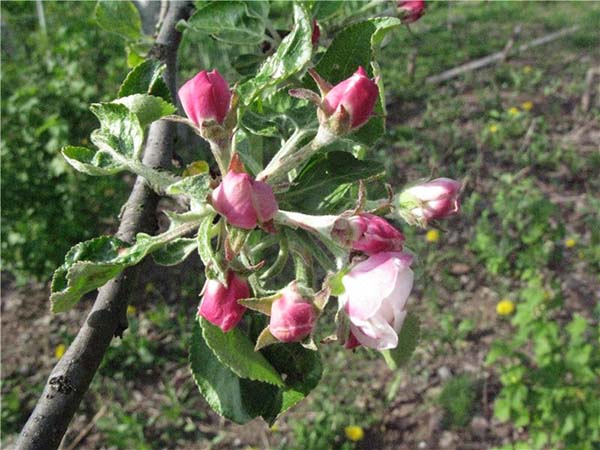
Spraying at the "rosebud" stage is also carried out against pests and diseases.
Naturally, at this stage no one processes any Bordeaux liquid, copper or iron vitriol, but continues (or just starts) to use serious drugs such as Horus or Skor, Decis Profi, Kinmix, Karate Zeon.
By the way! Temperature conditions at the “rosebud” stage, as a rule, improve, the weather is warm and sunny (temperature + 10-15 degrees and above), which means that you can start using biological preparations (Fitoverm, Bitoxibacillin, Lepidocid, etc.).
On the ovary with a pea (after flowering)
Immediately after flowering, when pea-sized ovaries are formed, it is necessary to carry out treatment as from disease (especially against moniliosis in stone fruits, however, as with pome fruits)and against pests (against apple moth).
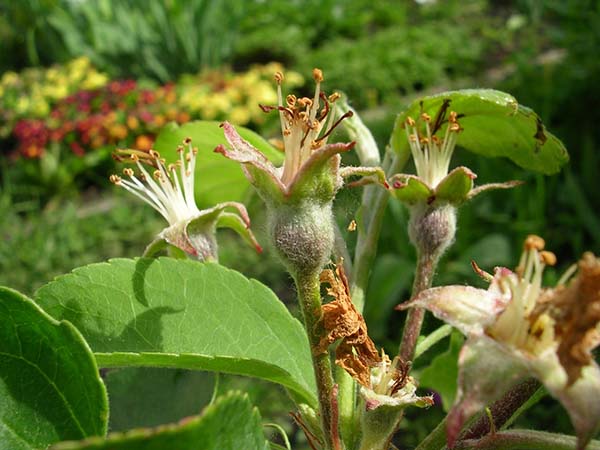
Preparations (fungicides and insecticides) are used similar (as in the previous stage), including the active use of biological products.
How to properly spray your garden in spring
Basic rules and recommendations for effective spring spraying of the garden against diseases and pests:
- During the preparation of solutions and spraying of plants observe safety precautions... If the packaging of the drug (fungicide or insecticide) says that you need to wear special clothes (gown, overalls, raincoat), goggles and a respirator, rubber gloves, then you need to wear it.
- Processing should only be carried out in dry and calm weather.
In sunny weather, it is better to refrain from spraying, since, quickly drying out, the drugs become ineffective or do not work at all. Spraying is best done in cloudy, calm weather, but not in the rain: after the rain, the branches are wet, they have a kind of thin "film" of water. And spraying is droplets of solution, which cover the plant with a thin "film" of drops in the same way. If processing is carried out, then the concentration of the solution will decrease, and the processing efficiency will decrease.
- Spraying is desirable early morning (after dew has dried) or late at night (after sunset).
- Processing is always carried out exactly after spring pruningto further protect the cut sites (ideally, if sprinkled with copper sulfate or Bordeaux liquid, in other words, if the fungicide contains copper).
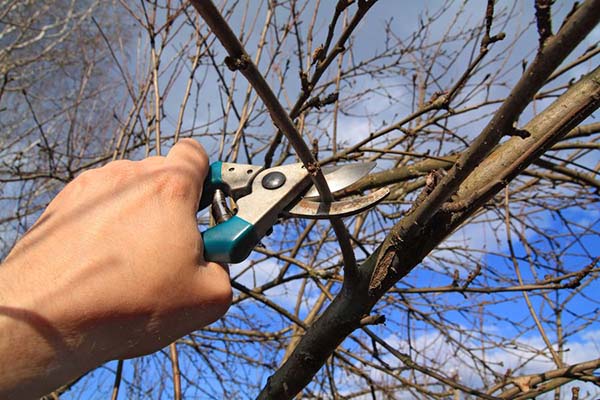
- Do not do it spraying during flowering specifically against pests (can harm bees and other pollinators). Allowed perhaps processing against disease.
- At each stage, you can use kthe same drugs (in order to save money), and new (with different active ingredients, so that there is no addiction - it will be more effective), or alternate (use alternately).
- All prepared solutions should be pass through a filter meshso as not to clog the sprayer.
- Suitable for dissolving almost all drugs room temperature water (for vitriol - it is advisable to use hot, about + 40-50 degrees).
And if you are using a biological product, then it is better to take settled or filtered water, i.e. chlorine free.
- You can cooktank mixwho will possessinsecticidal and fungicidal properties (in this case, it is imperative to clarify the compatibility of drugs).
However! Some agronomists believe that do not immediately give a double chemical load on the plant... It is better to take a break for at least 1 day (for example, treat it with a fungicide on Saturday morning, and an insecticide on Sunday morning). You can also spray at intervals of 1 week, i.e. on one weekend they were treated for pests, on the next - for diseases (or vice versa).
The specifics of processing adult (old) and young trees
Mature trees and shrubs should preferably be treated in 4 stages, with at least 4 sprays.
Until the tree blooms, insects stick to it less, therefore young seedlings and shrubs it will be enough to process only 2 times:
- on sleeping buds from diseases and hibernating pests;
- "On a green cone" from insect pests.
Advice! Young pome and stone fruit trees are best treated 3 times. After flowering, when pea-sized ovaries are formed - from diseases, especially against moniliosis (monilial burn).
Peculiarities of processing fruit trees and berry bushes
In the spring, you need to process both fruit trees and shrubs. If you process only trees, and forget about shrubs, then some diseases and pests can again spread to the trees.
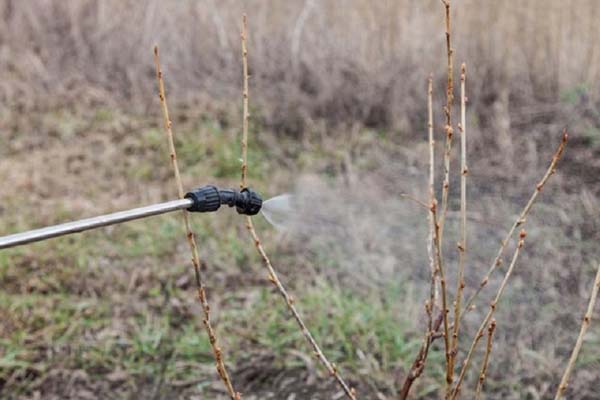
However, it should be borne in mind that, for example, currants begin their growing season earlier than most of the trees.
In general, as a rule, trees and shrubs are sprayed immediately in the spring, except that grapes processed separately, possibly still strawberries (garden strawberries).
Advice! On the specifics and differences in the processing of berry bushes (namely currants and raspberries) you can find out in the following video:
Video: protection and treatment of currants and raspberries from pests and diseases - how to spray shrubs in spring
What diseases and pests are used for spring garden treatment
Next, we will consider which fungal diseases and insect pests you will fight and protect the garden against in the spring.
By the way! The site has separate detailed articles about what and how to treat specific fruit and berry crops against diseases and pests in spring:
- apple trees and pears;
- cherries and cherries;
- peaches;
- currant and gooseberry;
- raspberries and strawberries;
- grapes.
Diseases
Spring processing of the orchard is carried out against the following fungal diseases of fruit trees and berry bushes:
- Apple tree - scab, moniliosis (fruit rot or monilial burn), rust.
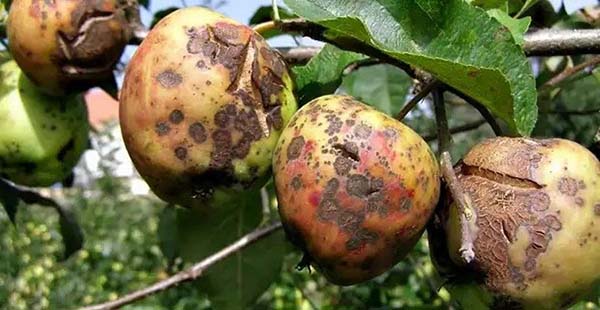
- Pear - scab, phyllostictosis (brown spot), septoria (white spot), moniliosis (fruit rot or monilial burn, rust.
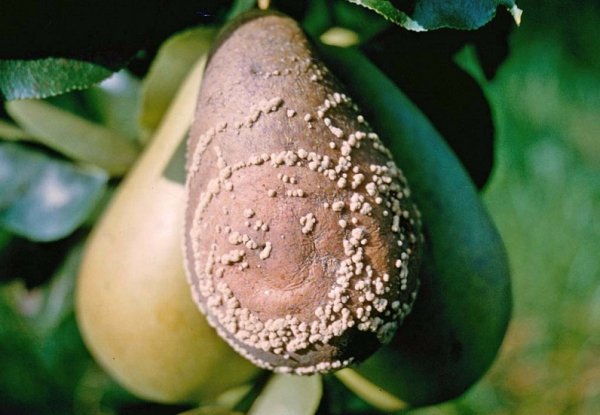
- Cherry, sweet cherry - coccomycosis (reddish-brown spot), clotterosporia (perforated spot), moniliosis (monilial burn or fruit rot)... On very rare occasions, cherry trees strike scab, anthracnose and rust.
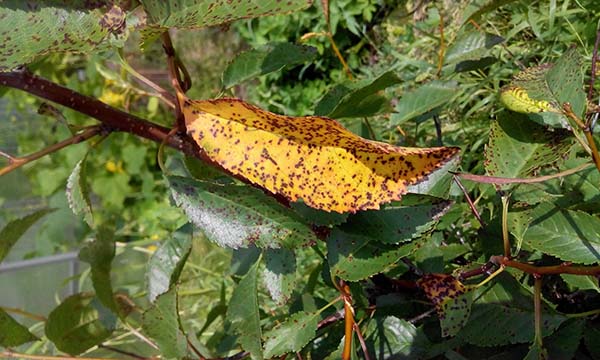
- Plum, cherry-plum - klyasterosporiosis (perforated spot), polystygmosis (red spot of plum or cherry-plum), moniliosis (monilial burn).
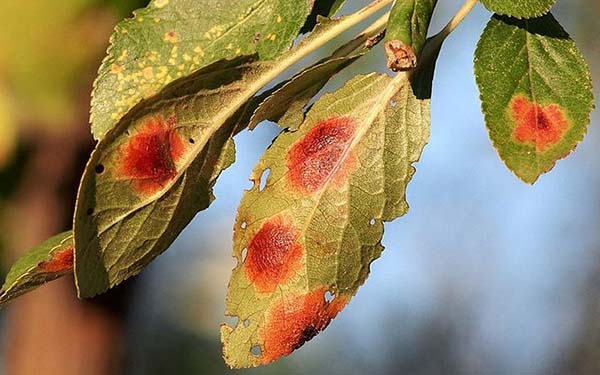
- Apricot, peach - klyasternosporia (perforated spot), curly peach leaves, moniliosis (monilial burn, fruit rot), powdery mildew, scab.
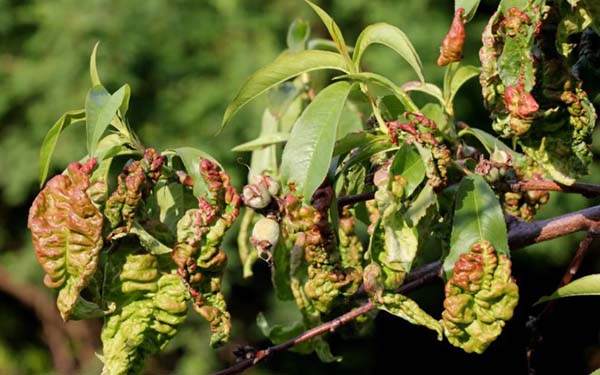
- Raspberry - anthracnose, septoria (white spot), raspberry purple spot (didimella), gray rot (botrytis).
- Strawberries (garden strawberries) - powdery mildew, gray rot (botrytis), white spot (septoria), buray spotting.
- Grapes - oidium (powdery mildew), mildew (downy mildew), anthracnose, gray rot.
Thus, almost all fruit crops are affected by one or another spot, as well as various rot or powdery mildew.
Pests
The most the first processing of pome (apple, pear) and stone fruit (cherry, plum, cherry plum, apricot, peach) carried out against the following wintering stages of pests:
- scabbards;
- worms;
- aphids;
- ticks;
- suckers and other sucking and leaf-eating pests.
Second and subsequent treatments of apples and pears (seed crops) is already being carried out against the following pests:
- apple flower beetle or apple flower beetle;
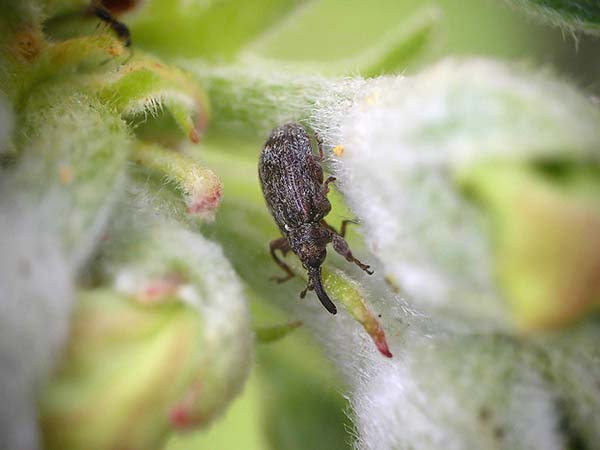
- apple fruit sawfly;
- green apple aphid;
- apple moth;
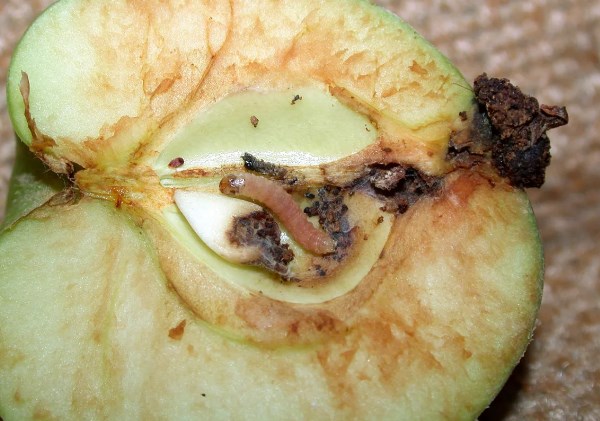
- gray bud weevil;
- bukarka;
- goose;
- leafworm and other leaf-eating;
- kidney eaters;
- suckers;
- moth.
Concerning stone fruit crops (cherry, plum, cherry plum)then already second and subsequent treatments is carried out against such pests as plum aphid, gray kidney weevil, goose, cherry weevil, plum black sawfly, mining moths, leaf-eating caterpillars, oriental moth, cherry moth, cherry slimy sawfly, yellow plum sawfly, plum fruit moth, plum cherry fly , plum-pollinated aphid.
Pests of berry crops (currants, gooseberries, raspberries), against which spring treatments are carried out, are:
- kidney mite (mite buds on currants);
- spider mite;
- strawberry mite (on strawberries);
- aphid;
- sawfly;
- gooseberry moth;
- raspberry fly;
- raspberry beetle;
- raspberry-strawberry weevil;
- kidney moth;
- glass case;
- moth;
- goldfish;
- galitsa (shoot and stem).
How to process the garden in spring: the best preparations
To successfully process the garden in the spring, you will need fungicides (drugs for combating diseases) and insecticides (drugs for controlling insect pests), and these agents can be of both chemical origin and biological (biological products).
The instructions for each drug always say when (in what time frame) they need to be processed.
Are chemicals dangerous, is it better to use biological products
Many gardeners have preconceived notionthat the use of chemicals will necessarily negatively affect the quality of the future harvest and human health. However, this does not correspond to reality, since upon expiry of the waiting period, all harmful substances (pesticides) withdrawn long before ripening and harvesting.
Important! Naturally, you must fully comply with the recommendations for their dosage and the timing of the spraying.
- Unlike biological products, chemical agents act much faster and more reliable.
- In addition, the use of chemicals is very often the only way to cure the culture from fungal diseases and get rid of annoying pests.
Whereas biological preparations have a more gentle effect, which is permissible only in the following cases:
- with a small number of pests;
- at the initial stage of development of a fungal disease or mild infection, and even better as a prophylaxis (protection), but not with an active struggle.
Chemical fungicides
As for the preparations suitable for spring spraying the garden against diseases, the following can be used fungicides (chemical agents for combating fungal plant diseases):
Important! For one treatment you only need to chooseone drug (fungicide), and then use a new one (preferably with another active substance) or alternate.
- Bordeaux mixture (contact fungicide of protective action, 3% solution - before bud break and 1% - at the stage of "rose bud");
By the way! The site already has a detailed article about the preparation and use of Bordeaux liquid.
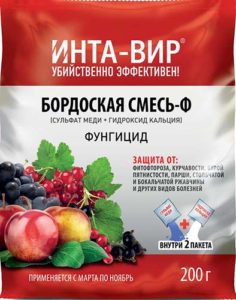
- Copper sulfate (contact protective fungicide);
Advice! More details on the fields of application of copper sulfate read in this material.
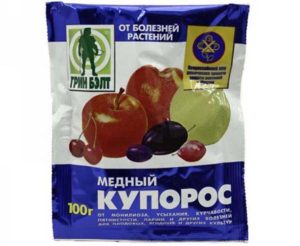
- Abiga peak (contact fungicide based copper oxychloride, against scab, moniliosis, clasterosporiosis - perforated spot, coccomycosis, curly leaves, powdery mildew and other diseases);
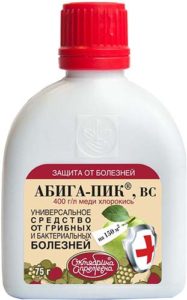
- Hom (contact fungicide based copper oxychloride);
- Oxyhom (contact-systemic fungicide actions based on copper oxychloride and oxadixyl, against scab, moniliosis, various spots: klyasterosporiosis - perforated spot, coccomycosis - brown spot, curly leaves, powdery mildew, mildew, anthracnose and other diseases);
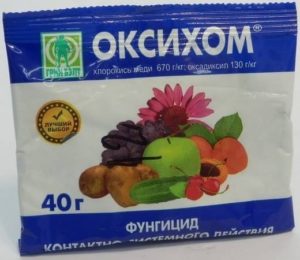
- Ordan (contact systemic fungicide based copper oxychloride and cymoxanil, very effective against mildew on grapes);
By the way! Some believe (partly rightly) that treating plants with copper-containing preparations is harmful to human health. But copper is by no means the most harmful drug, especially in such doses and at such an early time when fruiting is still very far away.
It should be understood that it is in early spring that there are practically no other effective substitutes (except perhaps the use of ferrous sulfate). Biological drugs are completely ineffective (do not work) at low temperatures.
- Inkstone (contact protective fungicide);
Advice! About, when, how and why to use iron vitriol, detailed in this article.
- Carbamide (urea);
Usually,urea is used together withcopper or iron vitriol, namely, the tank mixture is being prepared.
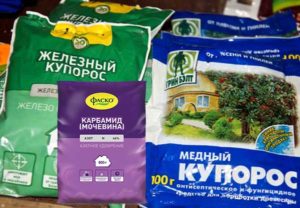
- Tiovit Jet (contact fungicide based sulfur, especially effective against powdery mildew and mites);
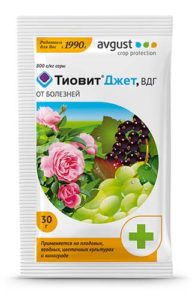
- Forecast (systemic fungicide based propiconazole, against powdery mildew, powdery mildew, curl of peach leaves, gray rot, anthracnose, septoria - white spot, rust and other spots);
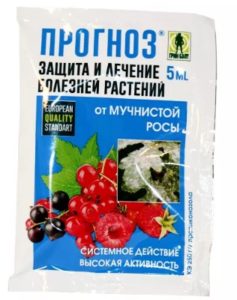
- Tilt (systemic fungicide protective and healing actions based onpropiconazole, against powdery mildew, powdery mildew, curl of peach leaves, gray rot, anthracnose, septoria - white spot, rust and other spots);
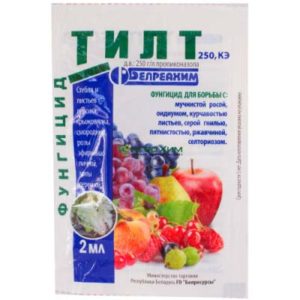
Tilt = Forecast (drugs have the same active ingredients).
- Horus (systemic fungicide based cyprodinil, against scab, moniliosis, fruit rot, coccomycosis, alternariosis, clasterosporiosis - perforated spot, curly leaves, powdery mildew, powdery mildew, mildew, gray rot and other diseases);
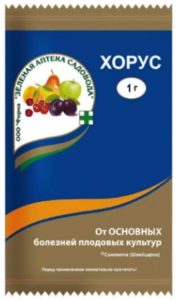
- Speed (systemic fungicide based difenoconazole, against scab, moniliosis, fruit rot, powdery mildew, coccomycosis, phyllostictosis - brown spot, clasterosporiosis - perforated spot, curly leaves, septoria, anthracnose, black spot and other diseases);
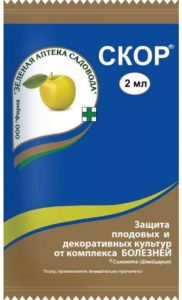
- Raek (systemic fungicide based difenoconazole, against scab, moniliosis, fruit rot, powdery mildew, coccomycosis, phylostictosis - brown spot, clasterosporiosis - perforated spot, curly leaves, septoria, anthracnose, black spot and other diseases);
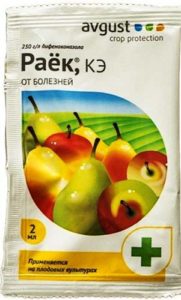
- The keeper (systemic fungicide of protective and curative action based difenoconazole, against scab, moniliosis, fruit rot, powdery mildew, coccomycosis, phylostictosis - brown spot, clasterosporiosis - perforated spot, curly leaves, septoria, anthracnose, black spot and other diseases);
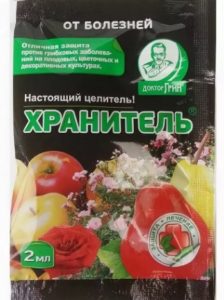
Speed = Raek = Keeper (the preparations have the same active ingredients).
- Strobe (systemic fungicide based kresoxim-methyl, against scab, powdery mildew, anthracnose, curl, rust, oidium, mildew);
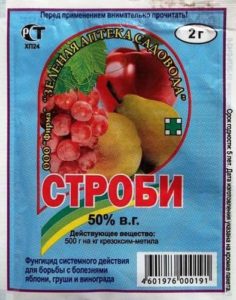
- Topaz (systemic fungicide basedpenconazole, against powdery mildew on berry crops, for example, currants);
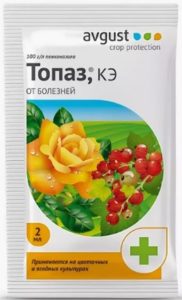
- Fundazol (systemic fungicide based benomila, against scab, powdery mildew, powdery mildew, gray rot and other diseases);
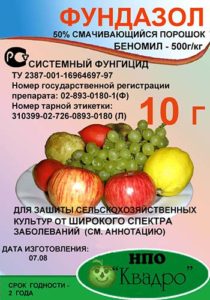
- Bayleton (systemic fungicide based triadimephone, against scab, powdery mildew, curly leaves, rust, oidium, gray rot, and other diseases);
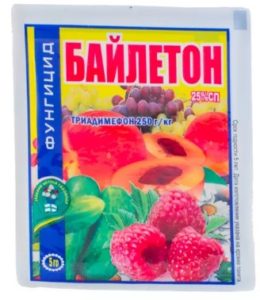
- Topsin-M (systemic contact protective fungicide actions based onthiophanate methyl, against coccomycosis, moniliosis - fruit rot and monilial burn, powdery mildew, scab, anthracnose and other diseases);
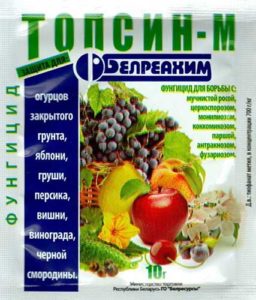
- And other contact and systemic fungicides of a wide spectrum of action.
Advice! Carefully study the instructions: the scope of the drug (against what diseases), timing, dosage!
Chemical insecticides
As for preparations suitable for spraying the garden in spring against pests, the following insecticides can be used - chemical agents for pest control (the active substance and method of exposure are indicated in brackets):
Important!For one treatment you only need to choose one drug (insecticide), and then use a new one (preferably with another active substance) or alternate.
- Aktara (Thiamethoxam (Aktara), systemic insecticide of intestinal action);
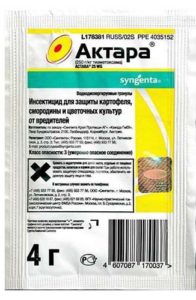
- Actellic (Pirimiphos-methyl (Actellic), systemic insectoacaricide of contact-intestinal action, against a complex of pests);
- Alatar (Malathion and Cypermethrin, enteric insecticide);
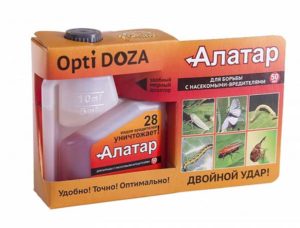
- Inta-Ts-M (Cypermethrin and malathion, enteric insecticide);
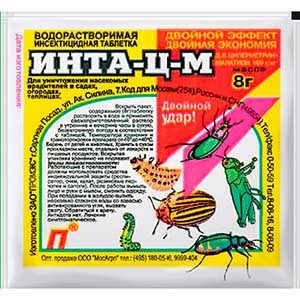
Alatar = Inta-Ts-M (identical active ingredients).
- Fufanon Nova (Malathion (Karbofos), enteric insectoacaricide);
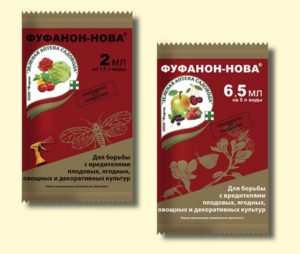
- Aliot (Malathion (Karbofos), enteric insectoacaricide);
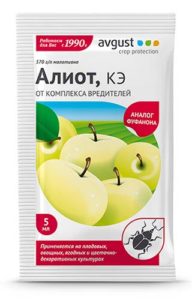
Fufanon and Aliot are complete analogues!
- Decis Profi (Deltamethrin,enteric insecticide);
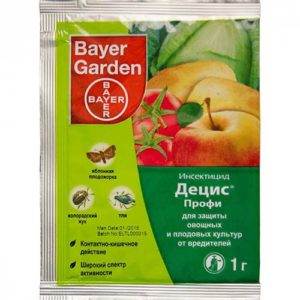
- Decis Expert (Deltamethrin, enteric insecticide);
- Calypso (Tiacloprid, systemic insecticide of contact-intestinal action);
- Karate Zeon (Lambda Cyhalothrin,enteric insectoacaricide);
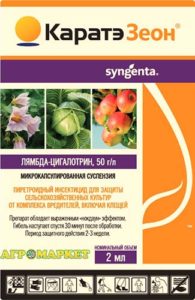
- Kinmix (Beta-cypermethrin, enteric insecticide);
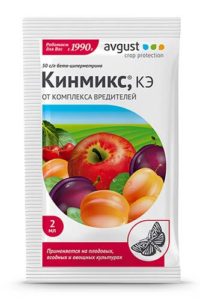
- Biotlin (Imidacloprid, systemic insecticide of contact-intestinal action);
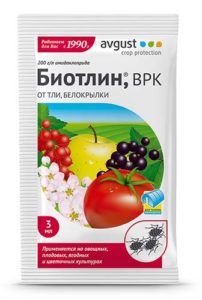
- Confidor Extra (Imidacloprid, systemic insecticide of contact-intestinal action);
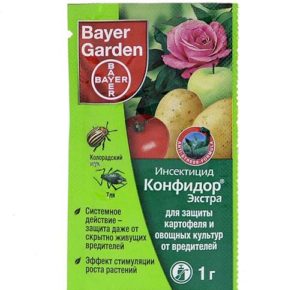
- Tanrek (Imidacloprid,systemic insecticide of contact-intestinal action).
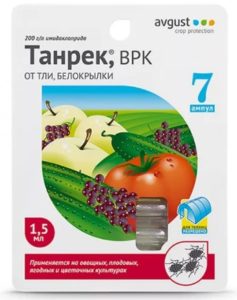
Tanrek = Confidor Extra = Biotlin (preparations with the same active substance).
- Brand (Emamectin benzoate,insecticide of intestinal action);
- Spark (Permethrin and Cypermethrin, insectoacaricide of intestinal action);
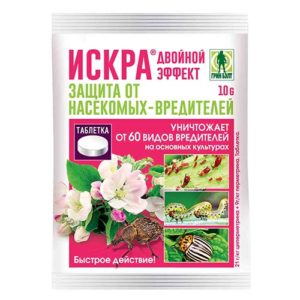
- Inta-vir (Cypermethrin,enteric insecticide);
- And other broad-spectrum insecticides.
Advice! Carefully study the instructions: the scope of the drug (against which pests), timing, dosage.
Video: how to spray trees in spring from insect pests
Biological products against diseases and pests
Biological products are based on living organisms:
- mushroom antagonists;
- bacteria;
- bacterial viruses;
- beneficial insects (entomophages and acariphages).
Note! As a rule, almost all biologics work effectively only under the condition of a sufficiently high positive air temperature (+ 10 ... + 15 degrees), so they begin to be used only at the stage of the "rosebud", while the first and second treatments you still have to carry out using chemicals.
Among biological products, fungicides, insecticides, as well as oneinsectofungicide.
Biological products with fungicidal action (against diseases):
- Alirin-B (Bacillus subtilis strain B-10 VIZR, systemic contact fungicide of protective and curative action);
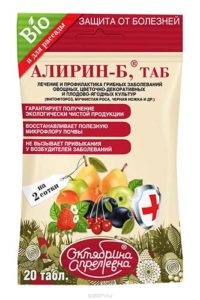
- Gamair (Bacillus subtilis strain M-22 VIZR, systemic contact fungicide of protective and curative action);
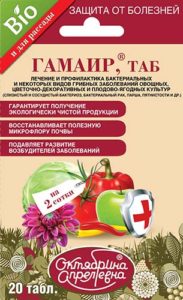
- Fitosporin (Bacillus subtilis strain 26 D, systemic fungicide of protective and curative action);
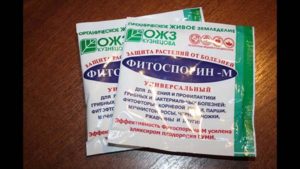
- Planriz (Pseudomonas fluorescens strain AP-33, contact fungicide);
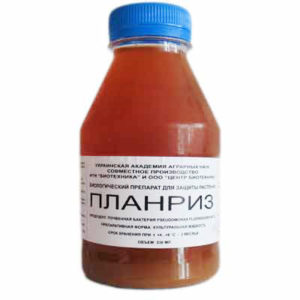
- Rizoplan (Pseudomonas fluorescens strain AP-33, contact fungicide);
Planriz and Rizoplan are complete analogues.
- Pentafag-C (containing virions of five strains of bacterial viruses, as well as biologically active substances, has a preventive and therapeutic effect);
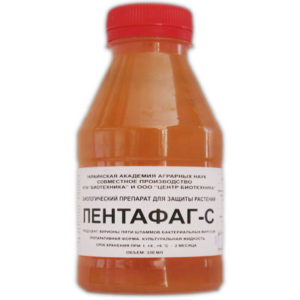
- Trichoderma Veride (Trichoderma veride, strain 471, protective fungicide);
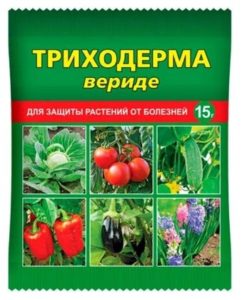
- Trichoplant (Trichoderma lignorum, protective fungicide);
- Trichocin (Trichoderma harzianum, protective fungicide);
- Trichodermin (protective fungicide);
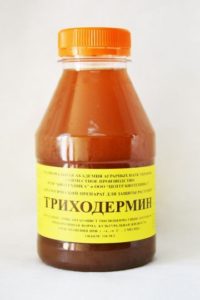
Trichoderma, Trichocin, Trichoplant and Trichoderma Veride are all created on the basis of Trichoderma mushrooms.
- Sporobacterin (Bacillus subtilis and Trichoderma viride, strain 4097, systemic contact fungicide of protective and curative action);
- Fitolavin (Streptotricin antibiotic complex and Phytobacteriomycin, systemic contact immunizing fungicide).
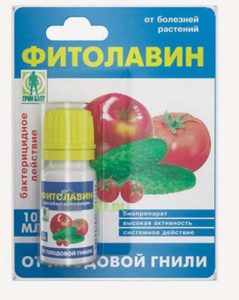
Insecticidal biological products (against pests):
- Fitoverm (Aversectin C, enteric insectoacaricide);
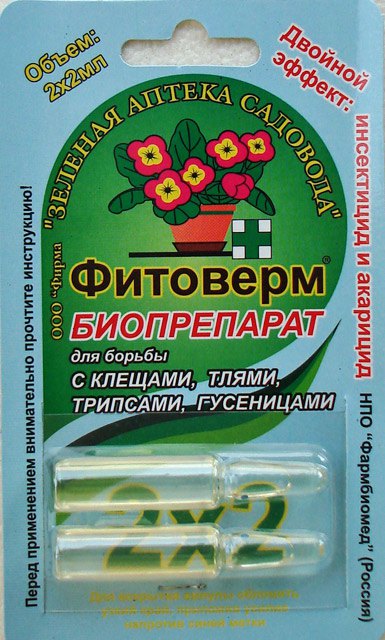
Aktofit and Fitoverm are complete analogues.
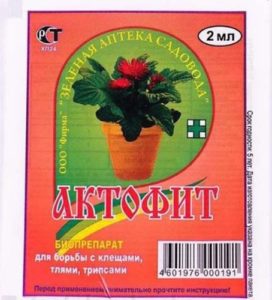
- Bitoxibacillin (Bacillus thuringiensis var. thuringiensis, intestinal insectoacaricide);
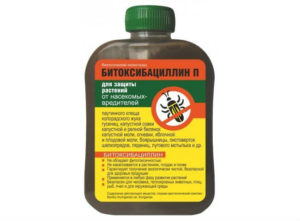
- Lepidocide (Bacillus thuringiensis var. kurstaki, intestinal insecticide);
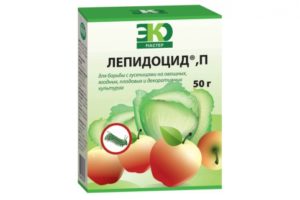
- Gaupsin (based rhizosphere bacteria Pseudomonas, insectofungicide contact and systemic action).
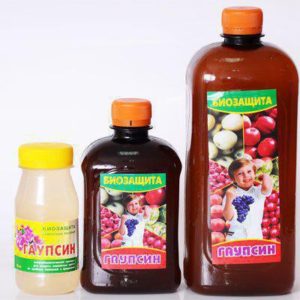
Note! Yes, biologics have their advantages (they are environmentally friendly), but we have to admit that they are not as effective as chemicals.
Tank mixtures (fungicides + insecticides)
Note! Not all drugs can be mixed. For example, practically nothing can be mixed with Bordeaux mixture (she has an alkaline reaction).
The instructions should say what drugs they can be combined with.
To carry out treatments (except for the first one, when the kidneys are still sleeping), the following tank mixtures (fungicide + insecticide) can be prepared:
- Horus (fungicide) + Decis Profi (insecticide);
At higher temperatures (+10 .. + 15 degrees)Chorus is better to replace with Speed.
- Horus + Aktara (insecticide) or Skor + Aktara (insecticide);
Advice! After flowering, it is advisable to replace Aktar with Actellic.
- Bayleton (fungicide) + Karate (insecticide);
- From biologics: Gaupsin (insectofungicide) + Lepidocide (insecticide) + Bitoxibacillin (insecticide) - from pests;
By the way! Almost all biologics can be mixed. Moreover, by doing so you will enhance their effect.
- Planriz + Trichodermin + Pentafag-C + Rizoplan - for diseases.
- AND a lot others.
Thus, now you have all the information for a successful spring garden treatment from diseases and pests. You just have to buy drugs (fungicides and insecticides) and monitor the development of your plants, as well as the weather.
Video: how to spray the garden in spring - processing fruit trees from diseases and pests


Thank you.)
Everything is clear, structured, without abstruse words and briefly).
Thank you, everything is clear and specific
Thank you, important information
Everything is planned out in stages - I definitely use all the tips.
Thank you so much for the useful information